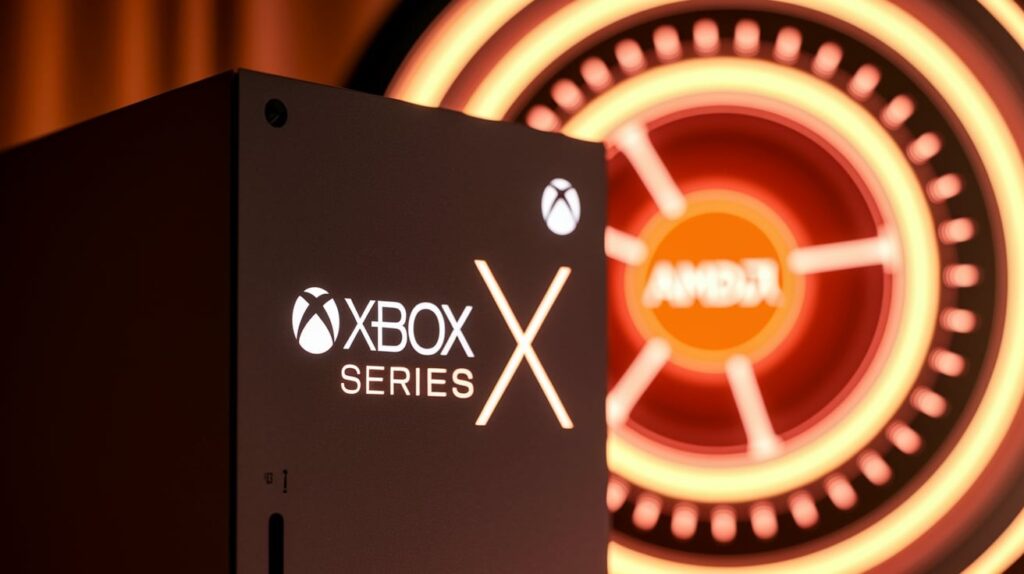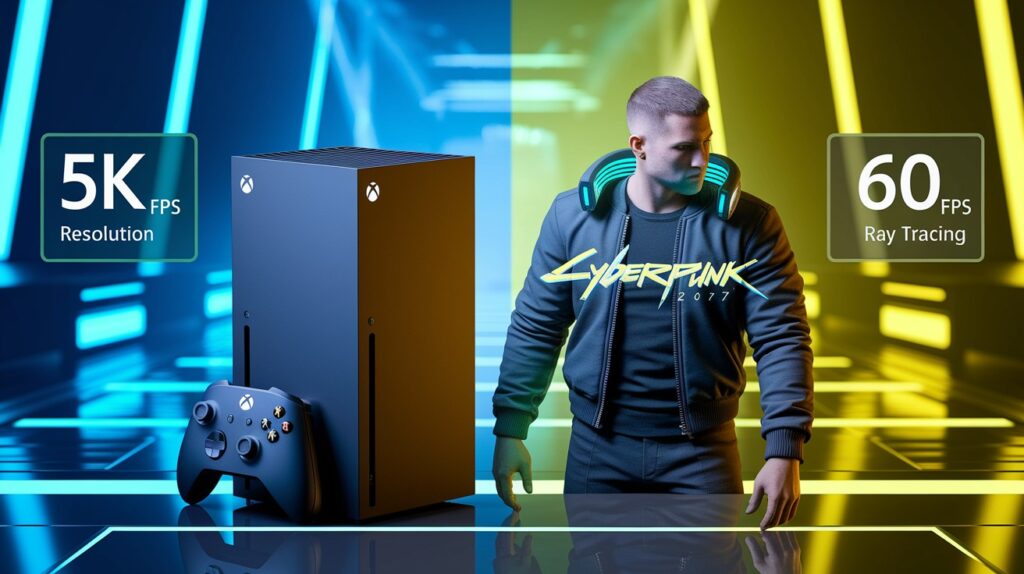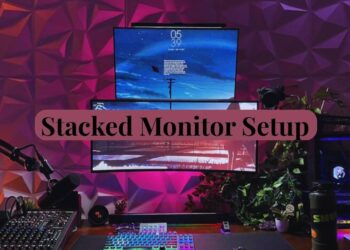Gaming on Microsoft’s Xbox Series X offers impressive visual performance that makes many PC gamers curious:
“What would it take to match this in my rig?” As 2025 unfolds, the comparison between console and PC hardware continues to shift.
The Series X packs substantial graphics muscle that once commanded a premium price tag in the PC space, but how does it stack up today?
This guide cuts through the technical jargon to show you exactly which current PC graphics cards match or exceed what the Series X offers.
We’ll examine raw performance, real-world gaming results, and help you understand what you’d need to spend to achieve comparable visual quality on your computer.
What GPU Does the Xbox Series X Use?

The Xbox Series X features a custom AMD GPU built on RDNA 2 architecture with 52 compute units running at 1.825 GHz, delivering 12.15 TFLOPs of raw power.
This graphics processor includes 3,328 shader cores and 16GB of shared GDDR6 memory.
Compared to the Xbox One X’s 6 TFLOPs, it offers twice the graphical performance while supporting hardware-accelerated ray tracing, something completely absent in previous Xbox generations.
How Console and PC GPUs Differ?
1. Shared vs Dedicated Memory
|
Feature |
Xbox Series X |
PC GPU |
|
Memory Type |
Shared GDDR6 (16GB total) |
Dedicated VRAM |
|
Memory Access |
Unified access for CPU/GPU |
Separate memory pools |
|
Bandwidth |
10GB at 560GB/s, 6GB at 336GB/s |
Varies by GPU model |
|
Memory Management |
Fixed, consistent allocation |
Dynamic, application-dependent |
2. Optimization and Performance Scaling
Console games benefit from focused optimization for standard hardware.
Developers know exactly what GPU they’re working with, allowing them to extract maximum performance through low-level code optimization.
This results in games that often look better than their raw specs suggest. Meanwhile, PC games must scale across countless hardware combinations, with programmers unable to optimize for specific GPU architectures.
This explains why a console with seemingly modest specifications can sometimes produce visuals that rival more powerful PC components.
The consistent environment of consoles enables performance tricks and targeted optimizations impossible in the variable PC ecosystem.
3. Why Direct Comparison Isn’t Always Perfect
Comparing console and PC GPUs strictly by specifications misses crucial contextual factors.
Console graphics benefit from specialized operating systems with minimal overhead, while PC GPUs contend with Windows and background processes.
Console systems utilize custom firmware that enables direct hardware access impossible on PCs. Additionally, console games use specialized APIs and rendering techniques specifically crafted for their fixed hardware.
The value proposition differs too; consoles aim for consistent performance at a fixed price point, while PC GPUs offer flexibility and upgradeability.
These fundamental architectural differences mean that comparing TFLOPs or core counts alone never tells the complete performance story.
Xbox Series X GPU Equivalent in 2025
1. Performance Benchmarks

4K Gaming Capabilities: The Xbox Series X handles 4K gaming admirably in 2025, typically running current titles at native 4K with frame rates between 30-60 FPS, depending on the game.
More visually complex games often implement dynamic resolution scaling, dropping to 1800p or 1440p during intense scenes to maintain smooth performance.
For comparison, modern PC GPUs targeting similar 4K capability need to sustain about 10-13 TFLOPs of computational power and at least 10GB of fast VRAM to match this level of visual fidelity.
Ray Tracing and Frame Rates: The Series X implements hardware-accelerated ray tracing for realistic lighting, reflections, and shadows.
In ray-traced games, the console typically aims for 30 FPS at 4K or 60 FPS at 1440p. Ray tracing implementation varies significantly between titles, with some games using minimal ray tracing for shadows while others apply it more extensively for global illumination.
The performance impact of ray tracing on Series X generally reduces frame rates by 20-30% compared to non-ray-traced modes.
Side-by-Side Performance Tests: Recent benchmarks show the Series X achieving 58 FPS average in Cyberpunk 2077 at 4K with medium ray tracing, while Forza Motorsport maintains a locked 60 FPS at native 4K with ray-traced reflections.
Call of Duty: Black Ops 6 runs at dynamic 4K resolution, averaging 1800p to maintain 60 FPS with partial ray tracing effects enabled.
2. PC GPUs That Match or Exceed It

AMD Equivalents (2025)
Radeon RX 6700 XT / 7600 XT Comparisons The Radeon RX 6700 XT (12GB VRAM) now closely matches the Series X performance, handling 4K gaming at similar visual settings.
The newer RX 7600 XT offers about 10% better performance than the Series X in rasterization while maintaining similar ray tracing capability.
Both cards typically range from $249-$329 in 2025’s market, making them cost-effective options for gamers seeking console-equivalent performance.
RDNA 2 vs RDNA 3 Advancements
|
Feature |
RDNA 2 (Series X) |
RDNA 3 (7000 Series) |
|
Architecture |
Monolithic design |
Chiplet design |
|
Compute Units |
Up to 52 CUs |
Up to 84 CUs |
|
Ray Tracing |
1st gen RT accelerators |
2nd gen RT accelerators (50% faster) |
|
Cache |
128MB Infinity Cache |
Up to 96MB Infinity Cache |
|
Memory |
GDDR6 |
GDDR6/GDDR6X |
|
AI Acceleration |
Limited |
Enhanced AI compute units |
|
Power Efficiency |
Good |
25% better performance-per-watt |
|
Manufacturing |
7nm process |
5nm/6nm process |
NVIDIA Equivalents (2025)
RTX 3060 Ti, RTX 3070, and Newer Options
The RTX 3060 Ti now offers roughly equivalent rasterization performance to the Series X but with superior ray tracing.
The RTX 3070 consistently outperforms the console by 15-20% across most titles. For current-generation alternatives, the RTX 4060 provides comparable performance to the Series X while consuming less power, though at a higher price point of $299-$349.
The newer budget-oriented RTX 4050 also approaches Series X capabilities in many games.
DLSS and Ray Tracing Performance
NVIDIA’s key advantage remains DLSS technology, which gives even older cards like the 3060 Ti a significant edge when upscaling from lower resolutions.
While the Series X utilizes AMD’s FSR 2.1, NVIDIA’s DLSS 3.5 with frame generation produces much better image quality and higher effective frame rates.
In ray tracing workloads, the RTX 3060 Ti delivers approximately 40% better performance than the Series X due to more advanced RT cores, allowing for more ray-traced effects at playable frame rates.
Price-to-Performance in 2025
1. Current Cost of Comparable GPUs
|
GPU Model |
MSRP |
Street Price (May 2025) |
Performance vs Series X |
Best For |
|
AMD RX 6700 XT |
$479 |
$249-$279 |
95-105% |
1440p/4K gaming, budget option |
|
AMD RX 7600 XT |
$329 |
$289-$319 |
110-120% |
1440p/4K with better FSR support |
|
Nvidia RTX 3060 Ti |
$399 |
$259-$299 |
100-110% |
1440p gaming with DLSS, entry RT |
|
Nvidia RTX 3070 |
$499 |
$329-$369 |
115-130% |
Solid 4K, good RT performance |
|
Nvidia RTX 4060 |
$299 |
$289-$319 |
105-115% |
Efficient 1440p, DLSS 3 support |
|
Nvidia RTX 4060 Ti |
$399 |
$349-$389 |
125-140% |
4K gaming, advanced RT features |
|
Intel Arc A770 |
$329 |
$229-$259 |
90-105% |
Budget 1440p, inconsistent performance |
2. Xbox Series X as a Value Option
The Xbox Series X remains an exceptional value at its current $399 price point in 2025.
When you factor in the complete gaming system, including CPU, storage, memory, and cooling, the console offers graphics performance that would cost at least $800-900 to match in a complete PC build.
The Series X also benefits from Microsoft’s consistent software support, automatic game optimization, and simpler setup process.
Where the console truly shines is its all-in-one approach. For many casual gamers, the plug-and-play nature combined with Game Pass subscription options creates a low-friction gaming experience with minimal upfront investment.
The console also maintains stable performance without the technical knowledge required for PC maintenance, driver updates, or component compatibility issues.
However, the value calculation shifts for users who need a computer for non-gaming tasks or who want the flexibility to upgrade components individually as technology advances.
While the Series X provides excellent gaming value today, its fixed hardware will gradually fall behind the PC performance curve over the next few years.
3. Building a PC with Equivalent GPU Performance
Creating a PC that matches the Xbox Series X graphics capability requires more than just an equivalent GPU. A comparable build in 2025 would include:
- CPU: AMD Ryzen 5 7600 ($199) or Intel Core i5-13400F ($179)
- GPU: RX 6700 XT ($269) or RTX 3060 Ti ($279)
- RAM: 16GB DDR4-3600 ($59) or 16GB DDR5-5200 ($79)
- Storage: 1TB NVMe SSD ($69-89)
- Motherboard: B650 or B760 board ($139-169)
- Case, PSU, Cooling: ($150-200)
Total cost ranges from $865-995 for a system that approximates the Series X gaming performance. This represents a 2- 2.5x price premium over the console itself.
The PC does offer significant advantages, including access to a broader game library, free online gaming, cheaper game sales, modding capabilities, and the ability to use the system for productivity tasks.
The PC platform also allows incremental upgrades, replacing just the GPU in two years could restore a performance advantage without rebuilding the entire system.
For pure gaming value focused solely on graphics performance per dollar, the Series X maintains a clear lead in 2025.
However, for users seeking broader functionality or planning a long-term investment with upgrade paths, the PC route offers compelling flexibility despite its higher initial cost.
Use Cases: Gaming, Streaming, and Beyond
1. Gaming Performance on Modern Titles
- AAA Single-Player Games: Series X GPU equivalent handles most at 4K/30fps or 1440p/60fps with high settings
- Competitive Titles: Achieves 1080p/120fps or 1440p/60fps in games like Call of Duty, Fortnite, and Apex Legends
- Ray Tracing Performance: Manages ray-traced lighting at 1440p/30fps in demanding titles
- Open World Games: Maintains stable framerates in titles like GTA VI and Assassin’s Creed at 1440p with balanced settings
- Strategy/Simulation: Runs CPU-intensive games like Total War and Cities Skylines II at 60fps with moderate population/unit counts
2. Streaming, Recording, and Multitasking Power
- Live Streaming: PC equivalents manage 1080p/60fps Twitch/YouTube streaming with minimal framerate impact
- Local Recording: Capable of 1440p/60fps local game capture using GPU hardware encoding
- Background Applications: Can run Discord, browsers, and music apps with a 5-10% performance impact
- Multi-Monitor Support: Handles gaming plus secondary display for chat/guides with minimal performance penalty
- Content Creation: Adequate for streaming workflows, but may struggle with simultaneous streaming and high-quality recording
3. VR Readiness and Future-Proofing
- VR Capability: Meets minimum requirements for Quest 3, Valve Index, and mid-range PC VR headsets
- VR Performance: Runs most VR titles at 90Hz with medium settings on standard-resolution headsets
- AI Upscaling: DLSS/FSR support extends useful life for gaming at higher resolutions
- Expected Longevity: Will likely handle 1080p gaming for 3+ years, 1440p for 1-2 years before settings reductions
- Upcoming Technologies: Lacks hardware acceleration for newer rendering techniques appearing in cutting-edge 2025 titles
Frequently Asked Questions
Is the RTX 3060 better than the Series X?
The RTX 3060 slightly underperforms the Series X in raw power, but offers superior ray tracing and DLSS advantages for specific games.
What GPU is equivalent to PS5?
The PS5 GPU roughly matches an RX 6600 XT or RTX 2070 Super, with 10.3 TFLOPs and hardware ray tracing support.
Is 4070 better than PS5?
The RTX 4070 significantly outperforms the PS5 GPU, delivering about twice the gaming performance with better ray tracing capabilities.








